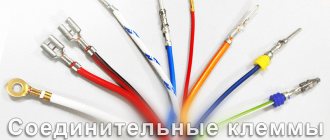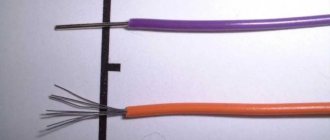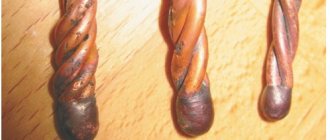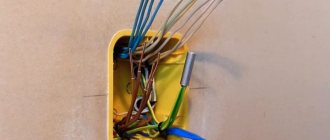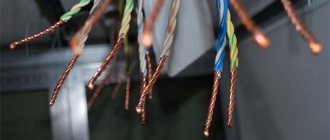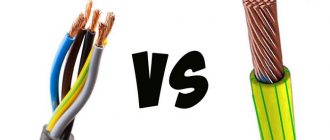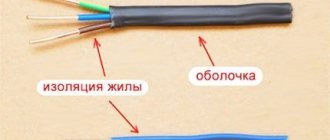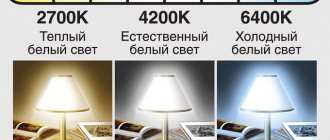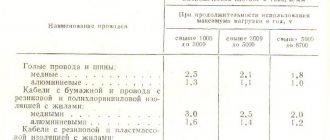How to choose a wire lug?
Crimping wires with lugs has recently become increasingly popular. After all, this simple and fast method allows you to create high-quality connections for both power and low-voltage networks.
And as you know, in any electrical systems it is a high-quality connection that ensures almost 90% of reliability. Therefore, in our article we decided to analyze the existing types of tips for crimping, their advantages and disadvantages, and, of course, the scope of application.
Purpose and areas of application
The main purpose of using cable lugs is to significantly improve the quality of electrical installation work and simplify the procedure for switching wires. Products are made from different metals, including aluminum and copper, which allows you to create transitions between different sources of electrical energy and installations.
These elements are universal, and the range of tips is very diverse. Thanks to this, you can find the most suitable option when performing certain installation operations. Each product is marked, which includes an indication of the conductor cross-section acceptable for switching. Only correctly selected tip sizes guarantee the most reliable and high-quality crimping of the wire (cable).
Sleeve tips
One of the most popular cable lugs is the sleeve. More often they are called sleeve ones, sometimes they are called “sleeve” or “tubular”. Sleeve tips are a thin-walled metal tube, often drawn, that is, seamless. But not always. There are sleeves made from a strip of metal simply rolled into a cylinder. The joint is not sealed. At home, thin-walled sleeve tips made of tinned copper such as NShV or NShVI are most often used. They are easy to install and provide good contact.
Sleeve or sleeve tips are a piece of thin-walled tube
There are sleeve lugs for different types of wires:
- No insulation. It is only a metal tube, sometimes with a socket on one side. The most common is NShV.
- With insulation. This is usually a plastic skirt. The most popular is NSHVI. They can be: with a round skirt - for cables and round wires;
- with a rectangular skirt - for flat wires.
- for one wire;
Pros and cons of different types of ferrules for wires
Sleeve lugs for wires differ from all others in that they are held in place by pressing the metal of the sleeve around the exposed conductors. This is what ensures good contact. The remaining types are held in place due to the fact that the upper part of the body is compressed. The contact area is smaller, but still quite sufficient for reliable operation.
Marking
The main criteria for classifying cable lugs are designs and materials of manufacture. Regardless of this, Russian-speaking countries have adopted a unified product labeling system, thanks to which a knowledgeable person can easily understand what material the item is made from and where it should be used.
The main letter designations include:
- A – material of manufacture – aluminum;
- L – brass;
- M – copper;
- T – metal with a tubular cross-section;
- U – angular.
You can often see the letter “O” on the elements. Its presence indicates that the product is equipped with a special viewing window, which allows you to visually verify the quality of the connection at any time.
Let's look at more advanced abbreviations:
- TML (O) – tubular tinned copper lug for wires for crimping with an inspection window (or without it, if the letter “O” is missing);
- NSHVI – pin bushing;
- NIK – ring.
Numerical values are added to the letter designations, which indicate the cross-sectional area or diameter of the product.
Connection of current-carrying conductors up to 10 mm/sq.
To organize branches and connections of aluminum and copper conductors, press jaws and standard sleeves are used. Connections in such cases can be one-sided, when the wire is inserted from one side of the sleeve, or two-sided. The material of the sleeves is selected in accordance with the material of the cores
Cable crimping algorithm:
1. At the ends of the cores, the insulation is removed by 2-3 centimeters. They must be cleaned to a metallic shine. If the conductors are aluminum, then they must first be lubricated with quartz vaseline paste. Copper wires, in turn, can be left clean.
2. In accordance with the technical table, punches, dies and sleeves are selected. If the sleeves are too large, then the free space can be sealed using additional cores. When using stranded conductors, removing the conductor wire to adjust the cross-section is not allowed.
3. The cores must not be twisted. They are laid parallel to each other, after which the connecting sleeve is put on. If copper wires are used, then before putting on the sleeve, they must be wrapped in two layers of copper or brass foil. The thickness of the foil is 0.2 millimeters and the width is 20-22 millimeters.
4. The connections are crimped using press pliers using the local indentation method. The degree of crimping is determined by the technical table.
5.After crimping, the connections are wiped with a rag soaked in gasoline and insulated.
Types and options
Structurally, tips are divided into two main types: single and double. Flaring can be performed at one end of the object, which is a necessary condition when working with multi-core conductors. A polyamide cuff is most often used as insulation.
According to the material of manufacture, electrical lugs are divided into the following types:
- Copper. Suitable for use exclusively with copper cable. In the manufacturing process, seamless tubes are used. A clamping part is installed on one side, and a tubular hole into which the conductor is inserted is installed on the other. These devices can be used during the installation of electrical devices, including input, distribution and grounding types of equipment.
- Aluminum ones are suitable for cores made of the corresponding metal. A contact blade with a special hole is placed on one side, and a tubular hole on the other. To fix the cores, the principle of crimping is used. An additional tool is required. To protect against oxidation, the tip must be coated with a lubricant made from a mixture of quartz and petroleum jelly.
- Aluminum-copper lugs are required in cases where the switchgear uses copper bars and the electrical wiring consists of aluminum conductors. The landing tube is made of aluminum, the blade with contacts is made of copper. The manufacturing process proceeds using the frictional diffusion method (gas dynamic spraying). The durability of the contact is due to the fact that the element is coated directly on top with copper plating.
Separately, it is worth highlighting the presence of bolted tips, the fixation in which is carried out by clamping bolts. In this case, there is no need for crimping, and the bolt is the main component of the product. A wrench is required to tighten the unit.
Design features
Depending on the type of design, single and double tips are distinguished. In order to use a tip for a stranded wire, the product is presented in the form of, for example, a copper tube with galvanic treatment. At the same time, the use of a polyamide cuff allows for high-quality insulation.
Correct selection for crimping
Before any crimping work, a high-quality selection of tips is carried out. Here it is important to take into account both the thickness of the sleeve or the diameter of the input sleeve, and the material of manufacture.
Note! When choosing the diameter of the inlet hole, you should focus on the diameter of the wire that has already been stripped of insulation. It must coincide with the tail of the product.
If an aluminum lug was selected, its cross-section should be identical to the wire. In the case of using copper products, some difficulties may arise, so it is best to do this:
- Look for a suitable solution in the GOST tables, but you will need to understand the flexibility classes of the cores.
- Manually measure the diameter using a special tool - a caliper. Next, the obtained result is compared with the cross-section of the internal hole, which is measured by the same device.
It is important that the materials from which the tips and cores are made are identical, since when copper interacts with aluminum without the use of protective reactions, corrosive processes will occur. This will lead to oxidation and subsequent short circuiting of the wiring, which does not bode well.
Power cable processing
For these purposes, you will need to use high-voltage wire lugs. They are made of copper with antioxidant protection. If the cable fluffs up after cutting, the edges are corrected with a sharpener. When unfolding the cable, you need to remove excess sections along the veins. It is important to avoid bending. Another caveat would be to avoid the soldering method, since contact on pure tin is not acceptable.
Read here! Wire insulation: insulation rules and methods of using modern materials (75 photos)
Basic rules for crimping
Follow several rules that will simplify the crimping process and improve the quality of the final result when working with cable lugs or sleeves:
- the tip must be selected technically competently, taking into account all the nuances;
- slowly strip the veins, removing all traces of insulation;
- When performing work, use only high-quality tools;
- find a matrix that is suitable for crimping;
- strictly follow the cable crimping sequence.
When using the tool, be sure to set the hole dimensions correctly, otherwise the connecting components may be damaged.
NShVI pin products
Pin sleeve lugs (abbreviated as NSHVI) are made from special electrolytic copper, the back of which is protected by an insulating layer. The material must be treated with galvanic tinning. In the domestic and industrial spheres, NShVI are used for crimping cables with a cross-section of 0.2 square meters. mm and above.
Note! In addition to letter markings, color markings are also used to indicate the diameter of the sleeve.
The nuances of working with NSHVI
NShVI are ideal for crimping multi-core wires, but will be inappropriate when working with a cable consisting of a single core. The crimping process is carried out as follows:
- Select the wire cross-section and cable lug of the desired brand. Make sure that the wires are inserted into the product from the “skirt” side.
- When choosing this component, make a certain reserve. For example, a wire whose cross-section is 1.25 square meters. mm, must be crimped with a tip with a cross-section of 1.5 square meters. mm and above with a “skirt” size of no more than 2.5 square meters. mm.
Required Tools
In the process of terminating a single or multi-core cable, a special tool is used to achieve the required force and ensure the reliability of the result. You should have on hand:
- Press pliers PK2 and PK2M are suitable for crimping wires whose cross-section does not exceed 10 square meters. mm;
- PK1 and PK1M are tools with increased power compared to hand pliers;
- hydraulic pliers, like PK2, can be used for cables with a cross-section of no more than 10 square meters. mm;
- In industrial enterprises, manual presses are used, suitable for cables with a cross-section of up to 250 square meters. mm;
- for conductors whose total cross-section is even larger, a hydraulic press equipped with an electric drive is used.
The presence of a ratcheting mechanism in the press jaws increases the reliability of the work: the tool will not loosen until it is completed.
Sleeves for wires for crimping
It is not always appropriate to use standard cable lugs, so instead of crimping, terminating with sleeves can be performed. For copper cables, GML (tinned copper) sleeves are used, for aluminum cables - GAO (closed aluminum sleeve). When two elements from different materials are connected, a sleeve made from an alloy of aluminum and copper is used.
Preparation for crimping
Before inserting the core into the tip, you need to perform careful preparation:
- Remove the insulation from the end of the wire of the required length (to do this, use a special tool to avoid damaging the wire).
- Twist all the strands by hand and push them inside the tip from the “skirt” side.
Features of using sleeves
Another method of connecting wires is to terminate using a sleeve. Sleeves marked GML are suitable for copper conductors. These are copper-tinned type sleeves.
But the termination of aluminum cores is done using sleeves of the closed GAO variety. When working simultaneously with copper and aluminum wires, alloy sleeves are required.
How to crimp a wire
Press pliers resemble ordinary pliers or pliers, with a matrix installed at the end. It is selected depending on the size and shape of the tip. It is into this that both the tip and part of the cable, stripped of insulation, are inserted. After this, just press down the handles using a little force. The tool itself will do the rest for you.
Single terminal crimp
Be guided by the following principles:
- to prevent the conductor from falling out of the tip socket, first install the connecting component in the press jaw matrix, and only then fix the cores;
- When performing crimping with press pliers, press on them until the ratcheting mechanism is activated, with the help of which the tool handles are blocked and the release is prevented;
- if you fix the tip and cores manually, then lightly pull your hand to control the process (high-quality fixation eliminates any movement of the cable inside the tip);
- Double-circuit crimping pliers work on a different principle - compressing an insulator with a bushing in sockets of different sizes;
- Whether you worked by hand or using a press, be sure to check the quality of the connection at the end by lightly pulling on the pieces of wire.
Advice! Before starting work, you can practice using some of the unnecessary wire. As soon as you achieve a high-quality connection, you can begin electrical work.
Double terminal crimp
When connecting two conductors, one contact is used. In a modular circuit breaker, the cores are switched using jumpers: one contact - two cables.
In this case, you should use NShVI for two conductors. Both multi-core cables are placed in the cuff, and crimping pliers must be used for crimping. To crimp a double-type tip, you should install a matrix with a cross-section of at least 6 square meters on the pliers. mm.
Crimping power cable lugs
When crimping power cables, tinned copper lugs are used, which are well protected from corrosion. If, when cutting the cable, its cores “fluff” significantly and become larger in diameter than the rest, then perform the work on a sharpener. When unrolling the cable, make sure that the circle removes excess knots along the cores and does not bend them.
Soldering is absolutely not suitable for crimping a power cable, since single tin contacts cannot be used on such wires.
Copper
These connector models are suitable for copper wires. It is made from a seamless tube. On one side there is a clamping part, and on the other there is a tubular hole for the wire. As a rule, this option is suitable for installing electrical appliances, grounding, and installing ASU.
Tips and tricks
A couple of simple tips. In order not to make a mistake when choosing a tip (copper or aluminum), take a piece of cable with you to the store, which will be crimped. Having it on hand will make it much easier to choose the correct sizes.
Each tip is selected individually for a specific cable. In case of discrepancy, crimping will be performed incorrectly. Never use homemade tips, do not cut the sleeve into two parts, trying to save money and use it at several points. Often, short circuits, fires and fires that lead to damage to property arise due to technically incompetent electrical installation work.
Bolted
The tips are fastened with a clamping bolt. Therefore, the crimping method is not used, and tightening is carried out using a wrench.
Technical specifications
The main types and brands of thin-walled insulated lugs and terminals widely represented on our market are the following:
NKI ring tips - all their data and technical parameters are given at the beginning of the article above.
NVI insulated fork lugs:
Insulated flat pin lugs NSHPI:
Insulated round pin lugs NShKI:
Connectors—flat insulated “female” terminals RPI-M:
Connectors - flat insulated male terminals RPI-I:
You can view the current prices for tools for crimping such tips here.
Common Mistakes
For crimp connections, select a sleeve of the appropriate size. If the diameter of the core is larger, then it has to be sharpened. Its thinning leads to an increase in the resistance of the contact area. In this place the wire will heat up and may burn out over time. Mechanical strength is also lost. External influence on the connection can lead to rupture.
An increase in diameter, compared to a wire, similarly leads to a deterioration in contact. The presence of gaps between the cores reduces the reliability and strength of the connection. In order to save money, dividing the sleeve into several parts makes installation inconvenient and reduces the contact length. You should also not use improvised tools when crimping. Pliers, a hammer or a chisel will not bring the desired effect, but can cause irreparable damage.
Connecting wires using crimping will not be a problem. If the sections are consistent, the work is carried out carefully and safety precautions are followed, you can get an excellent result.
